Country Information - Islamic Republic of Pakistan اسلامی جمہوریۂ پاکستان (PART 04)
Culture of Pakistan
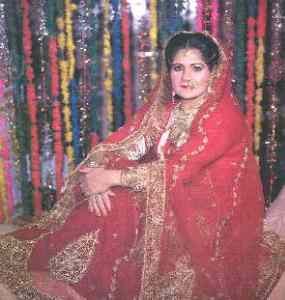

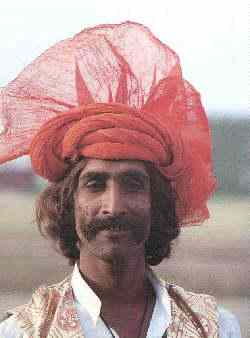
The culture of Pakistan is an amalgamation of influences various civilizations that thrived in this part of the world as old as 7000 BC (Mehrgarh) and Indus Valley Civilization(3500 BC–1800 BC). In the near past, or one can say from the start of the present era or the AD, religions like the Buddhism, Hindu aim and finally the Islam greatly influenced the way people of this part of the world live. This was further augmented by the culture of a series of invasions and invaders, who left their foot prints in the form of food, dress and way of living. One can see the differences in culture among the different ethnic groups in matters such as dress, food, and religion, especially where pre-Islamic customs differ from Islamic practices. The Kafir Kalash in the northern mountain region of Chitral greatly resemble the Greeks (Alexander 326 BC), while in other areas influences of the Dravidians, Aryans, White Huns, Persians, Mongols (Chenghis Khan), the Arabs (711 AD), the Afghans, the Moguls and finally the British can be easily recognized. The basic origin of Pakistanis however comes from the civilizations of North India and eastern Afghanistan, with significant influences from Persia, Turkistan and Hellenistic Greece. Therefore Pakistan abounds in ancient remains: Buddhist monuments, Hindu temples, palaces and monuments built by Emperors, tombs, gardens and Anglo-Mogul mansions. Sculpture is dominated by Graeco-Buddhist friezes, and crafts by ceramics, jewellery, silk goods and engraved woodwork and metalwork.
Therefore, what we see in Pakistan is in fact inherited from the rule of many foreign invaders that added their cultural traditions to the this part of the world. One of the most influenced cultures being the Mughal. However, there is one type of culture stems from the mainstream South Asian Muslim culture. Being generally conservatives, the people of Pakistan have been able to preserve their rich and unique cultural heritage throughout history. Religious practices of various faiths are an integral part of everyday life in society. Education is highly regarded by members of every socio-economic stratum. The traditional family values are highly respected and considered sacred, although urban families have grown into a nuclear family system, owing to the socio-economic constraints imposed by the traditional joint family system. Pakistani society is largely multilingual and multicultural. and over the past almost 60 years of integration of a largely diverse ethnic groups, a distinctive "Pakistani" Culture has sprung up especially in the urban areas.
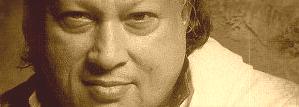
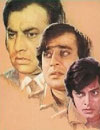
Nusrat Fateh Ali Khan (left) - Pakistan Film Once Famous Heroes (right)
Pakistani music is represented by a wide variety of forms. It ranges from traditional styles (such as Qawwali) to more modern forms that try to fuse traditional Pakistani music with western music. A famous Pakistani musician, Nusrat Fateh Ali Khan was internationally renowned for creating a form of music which synchronized Qawwali with western music. He even made scores with Peter Gabriel and many other musicians of the west. Popular forms of music also prevail, the most notable being Film music and Urdu Pop music. In addition to this are the diverse traditions of folk music. Pakistani films are generally made in the national language Urdu, but films in regional languages are also very popular, specially the Punjabi films which are liked all over the country. Lahore and Karachi are the main hub of film productions, and for its closeness to Hollywood, Lahore is known as Lollywood for film making. The films made in the 60s and 70s did wonderful business on box office, but presently the cinema in Pakistan is on the decline and not many quality films are produced these days.
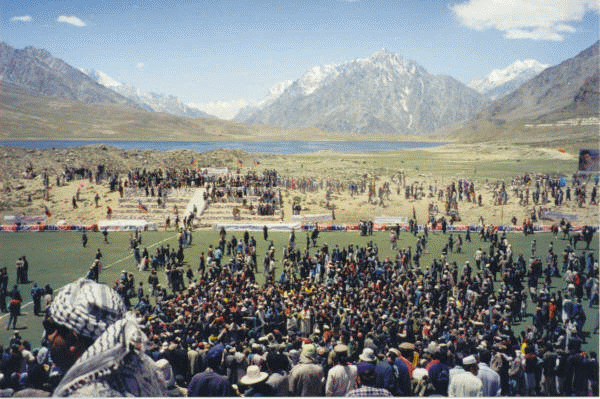 The sports in Pakistan has a very large diversity. While Polo is regarded as a traditional sport and played widely in the northern areas, specially at Shandur, the highest polo ground of the world. The official and national sport of Pakistan is field hockey, although squash and cricket are also very popular. The national cricket team has won the Cricket World Cup once (in 1992), were runners-up once (in 1999) and co-hosted the games twice (in 1987 and 1996). The team has also won the Australasia Cup in 1986, 1990, and 1994. The country will also be hosting the 2011 Cricket World Cup with India and Bangladesh. At the international level, Pakistan has competed many times at the Summer Olympics in field hockey, boxing, athletics, swimming, and shooting. Hockey is the sport that Pakistan has been the most successful at the Olympics, with three gold medals (1960, 1968, 1984). Pakistan has also won the Hockey World Cup four times (1971, 1978, 1982, 1994). Pakistan has hosted several international competitions, including the SAF Games in 1989 and 2004.
The sports in Pakistan has a very large diversity. While Polo is regarded as a traditional sport and played widely in the northern areas, specially at Shandur, the highest polo ground of the world. The official and national sport of Pakistan is field hockey, although squash and cricket are also very popular. The national cricket team has won the Cricket World Cup once (in 1992), were runners-up once (in 1999) and co-hosted the games twice (in 1987 and 1996). The team has also won the Australasia Cup in 1986, 1990, and 1994. The country will also be hosting the 2011 Cricket World Cup with India and Bangladesh. At the international level, Pakistan has competed many times at the Summer Olympics in field hockey, boxing, athletics, swimming, and shooting. Hockey is the sport that Pakistan has been the most successful at the Olympics, with three gold medals (1960, 1968, 1984). Pakistan has also won the Hockey World Cup four times (1971, 1978, 1982, 1994). Pakistan has hosted several international competitions, including the SAF Games in 1989 and 2004.
Pakistan recently stepped into the expensive sports of car racing and has participated in the A1 Grand Prix in the 2005 season. The Tour de Pakistan, modelled on the Tour de France, is an annual cycling competition that covers the length and breadth of Pakistan. Recently, football has grown in popularity across the country, where traditionally it had been played almost exclusively in the western province of Balochistan. FIFA has recently teamed up with the government to bring football more closer to the northern areas too. Also, it is hoped that Pakistan will fare better in the Football World Cup qualifiers for 2010.
Pakistani cusines have a deep impact of northern Indian, Persian, Turkish and Middle Eastern influences foods. However, the dishes are heavily peppered vegetables, meat, curries, spiced and barbecued beef, mutton or chicken, lentils (dhal), spicy spinach, cabbage, peas and rice with baked and deep-fried breads (roti, chapattis, puri, halwa and nan). Lately, Pizzazz and snacks are also becoming popular in cities with the mushrooming of western eateries. Like the rich spicy food, a wide range of desserts is also followed to lessen the burning left by hot and spicy foods. Though Pakistan is officially 'dry' (alcohol-free), it does brew its own beer (Murree Beer) and spirits which can be bought (as well as imported alcohol) from designated bars and hotels for non-Muslims only.
Like all countries, festivities are many. The two main religious festivals are the Eids. Chand Raat (the moon sighting night of Eid-ul-Fitr (just after the month of Ramazan - the month of fasting) is a festivity in itself. Girls putting henna on their hands, while most people throw parties at their houses. People flock the markets and bazaars for the last minute shopping for gifts and sweets that will be given to friends and families. Even outside at the malls and the plazas, there are many colourful lights. There are large crowds in the city centre to celebrate the beginning of Eid.
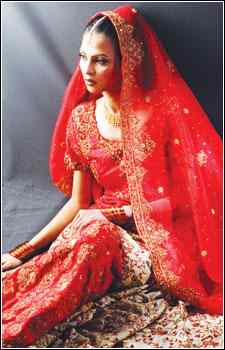
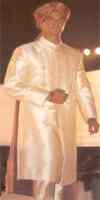
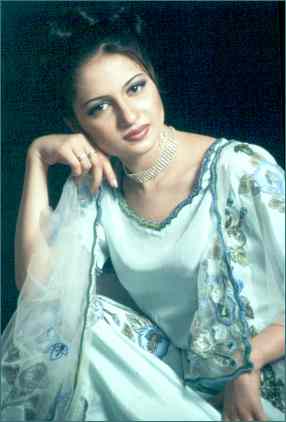
The attire for men mainly consist of Shalwar (a loose trousers), kameez (long shirt), Sherwani and Karakul (hat), while women add dopatta ( an unstitched matching cloth with Shalwar and Kameez) mainly to cover the body as is obligatory in Islam. The globalization has increased the influence of "Western culture" in Pakistan. Therefore, use of western clothes is mostly seen in the cities and government offices. Pakistan ranks 46th in the world on the Kearney/FP Globalization index. Many Western restaurant chains have established themselves in Pakistan, and are found in the major cities.
Pakistanis are highly spiritual people mainly due to the predominance of the religion of Islam, practiced by some 37% of its populace. The translation of Pakistan's name meaning land of the pure, implies spiritual purity. And one of the pillars of this spiritual purity is sexual purity, which over time, has become a part of the Pakistani sense of national identity. Sexual purity does not imply not having sex rather it only implies a complete avoidance of pre or extra marital sex. Unlike other Muslim countries of the East, specially the Arab countries, men in Pakistan seldom go for the second marriage (though marrying four women at a time is permissible in Islam) and those who do get married second time are generally not respected. Public displays of affection, even by married couples is seldom seen, while consumption of alcoholic beverages by Muslims in Public is not allowed. However, for non Muslims concessions are given to to buy alcohol with a permit, which is issued by the government of Pakistan. However, there are not many bars nor non-Muslims are allowed to drink publicly.
The social system of Pakistan is very different from that of the west, wherein the grown up children, specially the boys continue to live with their parents even after getting married. While the daughters are married off between the ages 18 to 25, and move in with her husband after marriage, the boys are always there - acting as the parents' social security, since there is no government run official 'social security' system that is administered. Thus the boys or at least one of the boys continue to stay with their parents all their lives and take care of them in their old age.
One of the social taboo is Honour killing or karo-kari, specially in the province of Sind and Punjab where any girl eloping with a lover is killed along with her lover by either of the aggrieved parents for the dishonour brought to the families. This self-proclaimed law continues unabated in many remote parts, however these days an awareness is taking place to stop this gruesome act and let the married couple live in peace. In December 2004, the government passed a bill making karo-kari punishable under the same penal provisions as murder.
Languages and Literature
With the arrival of the Muslims and later the British, India witnessed rise and fall of many foreign languages both as official and widely spoken national and regional languages. From Indian "Sanskrit" script to Arabic and Persian and later English and then revival of indigenous languages is a journey of more than a thousand years. This transition brought to fore one distinct change: Hindi for Hindus and Urdu ( a new language) for the Muslims, while English being common to both as official or "Daftari" language. Continuing with the British system of official language of, English continues to be the official language of Pakistan till date , while Urdu is the national language and lingua franca.
![]()
"Urdu", a language that has originated between the 11th to 13th centuries became a language for the invaders who came from different language regions. Later it also became the language of the Muslims. Although it is spoken as a first language by only 8% of the population, upon partition was recognised as the national language of Pakistan for its easy understanding by majority of the population.
Urdu derives its origin from the Turkish ""Orda" (camp). With he emergence of the Turkish and the Persians, a need was felt to have a common language which could be equally understandable by both the foreigners and the natives. So by combining the Hindi, Persian and Turkish, a new language was born. Camp followers, traders and native soldiers working with the invaders all helped to shape the original lingua franca, which is why Urdu is also known as the 'Lashkari (camp)' language. Urdu thus owes its syntax to the subcontinent as English does to Anglo-Saxon Dom. Like English it is harmonious and musical without being monotonous. Initially it was a more of a literary language, specially in poetry, than its household application. Mir Taqi Mair a renowned Muslim poet of 18th century once remarked that Urdu was the language that was spoken at the doorsteps of the Dheli's great red mosque. Hyderabad Daccen, which had a Muslim ruling class fostered Urdu culture. The language continued to be patronized more by the Muslims than Hindus and thus was adopted as the "National" language of Pakistan at the time of independence. Generally, the majority of Pakistanis can speak or understand two or more languages, one being Urdu which is widely understood and spoken in all parts of Pakistan, in addition to the native languages of each area.
The Regional Languages
"Sindhi" is the language widely spoken in the lower Sind province and is one of the oldest native languages of the subcontinent. With its unique spoken accent and four dots, it is very pleasant to listen to. 12% people, mainly in Sind speak Sindhi. Sindhi word is derived from the river Indus Called Sindh or Sindhu which runs from Ladakh to Arabian Sea. Sindhi language is an Indo-Aryan language which has mixed with Arabic Sanskirit and Persian with course of time. It has its own script which is similar to Arabic but with lot of extra accents and phonetic. There are 52 characters in Sindhi language. Quraan was first time translated into Sindhi in back in 12th century or earlier.
"Punjabi", is the language of Punjab and adjoining areas. As a first language, about 48% people all over Pakistan speak Punjabi. In addition to this, "Saraiki" a variance of Punjabi is spoken by around 10%. "Hindko" yet another regional language, mainly spoken in NWFP closely associates with Punjabi and about 2% speak this language. Punjabi, Hindko and Seraiki, all mutually intelligible, are classified by linguists as dialects of Lahnda. Added together, speakers of these mutually-intelligible languages make up nearly two-thirds of Pakistan's population. These are also, to a lesser extent, mutually intelligible with Urdu, and it can easily be understood by even those whose mother tongue is not Punjabi.
"Pushto" is the language of most of the people living in the NWFP and is also widely spoken in adjoining areas of Afghanistan. Although a little hard to speak has it own charm. 8% people of Pakistan speak Pushto, mainly in the NWFP and Balochistan.
"Balochi" is the language of the Balochistan province. Brahwi and Pushto languages are also spoken in the province. The ratio of Balochi and Brahwi is 3% and 1% respectively. Balochi and Pushto draw their roots from the Persian language.
The Literary Heritage
Urdu, with its Arab-Iranian scripture, became the vehicle for the Indo-Muslim culture and its gradual development in prose and poetry surpassed development in all other languages of the sub-continent. By its very nature and status it soon became the language of urban sophistication, classical tradition and scholarship and a link between various diverse linguistic groups. This perhaps explains the fact that Pakistani society has three cultural levels represented by Urdu as its national language, regional languages and the local folklore.
Besides religion, the only other aspect binding Pakistan together is Urdu language. Thus Urdu has stuck deep into the roots of Pakistani soil and environment and has come to be known as Pakistani Urdu, distinct from Indian Urdu in accent, tone, spirit and idioms. While it draws great influence from poets like Ghalib, Mir Dard, Mir Taqi Mir, the influence of poetry of Altaf Hussain Hali and Iqbal makes it different and rich, since Hali and Iqbal's themes have close relevance with our religious bonding. The Arabic, which once had been the official language after the Arabs in sub-continent and later the Persian have had tremendous effect on the development of Urdu. In fact the literary heritage of Pakistan has been enriched by Arabic, Persian and all regional languages of Pakistan. After independence, the rise and development of Urdu continues and men of letters like Ashfaque Ahmed, Bano Qudsia, Saadat Hasan Minto, Pitras Bukhari, Munno Bhai, Jamil ud Din Aali, Ahmad Nadeem Qasmi and like contributed in prose while Faiz Ahmad Faiz, Ibn e Insha, Ahmad Faraz, Nasir Qazmi, Parveen Shakir and Jaun Elia are some of the great names in poetry.

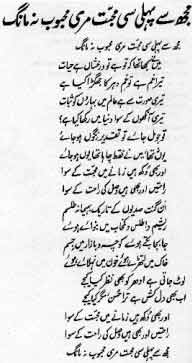 (Poetry to the left is that of Faiz Ahmed Faiz) Each of the regional languages of Pakistan is rich in treasure and tradition of high literature with mystical, romantic and heroic deeds. Baloch and Pushto draw great influence from the Persian language. In Balochi, there are a number of ballads narrating the heroic deeds of the tribal or Islamic heroes while popular songs display a remarkable tenderness of feelings and observation of nature. Balochi became a written language only recently and now modern Balochi literature is emerging. Pashto has a longer history as a language and its first written poem by Amir Karore is dated somewhere as back as 750 AD. Khushal Khan Khattak is great name in the development of Pushto (17th century) and the zenith of Pushto poetry reached in 17th / 18th centuries. This was the time when the Mughal Empire was its lowest and time for Urdu and other regional languages to flourish.
(Poetry to the left is that of Faiz Ahmed Faiz) Each of the regional languages of Pakistan is rich in treasure and tradition of high literature with mystical, romantic and heroic deeds. Baloch and Pushto draw great influence from the Persian language. In Balochi, there are a number of ballads narrating the heroic deeds of the tribal or Islamic heroes while popular songs display a remarkable tenderness of feelings and observation of nature. Balochi became a written language only recently and now modern Balochi literature is emerging. Pashto has a longer history as a language and its first written poem by Amir Karore is dated somewhere as back as 750 AD. Khushal Khan Khattak is great name in the development of Pushto (17th century) and the zenith of Pushto poetry reached in 17th / 18th centuries. This was the time when the Mughal Empire was its lowest and time for Urdu and other regional languages to flourish.
The greatest masterpieces in Punjabi and Sindhi were produced during this time and both languages share many tales and legends with rural tinge and mystic overflow. Punjabi has had a spoken tradition since middle ages and its first written work is found somewhere in 13th century in the form of mysic poetry of Baba Farid Shakar Ganj, Peelo in 16th century when he wrote famous "Mirza Sahiban". Madhu Lal Hussain is considered to be the first literary figure of Punjabi in 16th century. His contemporary Damodar was the first poet to versify the tragic love story of "Heer Ranjha". Then came Sultan Bahu with his famous "Si-harfi", followed by Baba Bullehsha, still known as great name in Punjabi poetry. Later Waris Shah developed the "Heer Ranjha" in 18th century to make it more close to hearts of all Punjabi speaking people.
Sindhi has been a literary language in 18th century and flourished since then. However ballads of Pirs Nurridin, Shamasuddin and Sadaruddin from 14th century indicate richness of the language. The mystic poets used the folklores of "Yusf-Zulikha, Saif-ul-Muluk and Sassi Punu" for the initial development of the language. The great name in Sindhi language is Shah Abdul Latif Bhitai, contemporary of Bulleh Shah, whose book "Shah jo Risalo" is somewhat treated as a religious book both by Muslims and Hindus of Sind. Sachal Sarmast is yet another great name in the development of Sindhi. Later Mirza Qalich Beg in the British times contributed a lot in the development of modern Sindhi language. In contemporary Sindhi poetry, Sheikh Ayaz figures out prominently who skilfully adopted old poetry into modern themes.
Folklores are though anonymous, but are very indigenous and natural growth of soil, projecting the life styles of rural people. Although, with more concentration on modern form of literature, specially poetry, folklores and folktales are being forgotten and are under serious threat.
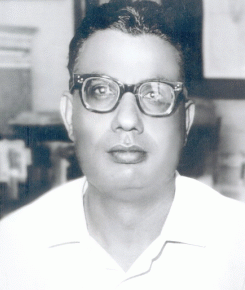
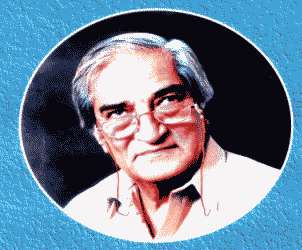

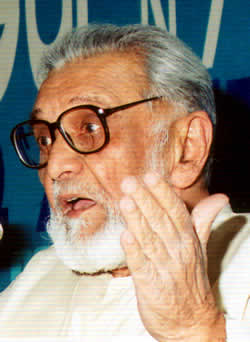


(from Left to Right) Ibn-e-Insha - Munno Bhai - Munir Niazi - Ashfaque Ahmed - Nasir Kazmi - Faiz Ahmed Faiz
Ibn-e-Insha was great humorist who wrote light poetry and fiction that not only pleased the readers, but also had hidden meanings for those who could understand the depth of his writings. Here is translated excerpt from his book "The Final Book", which is a parody of a child's elementary Urdu textbook:
| Shahjahan and the Taj Mahal Shahjahan was the son of Jahangir and the grandson of Akbar. He was not the apple of the eye of some architect or building contractor, nor was he the chief heir of a Public Works Department employee, as many people have assumed on account of the fact he erected so many buildings. |
Munir Niazi: One great name in Urdu as well as Punjabi poetry - known for his close to life verses, that pierce into the soul of the listeners, leaving an eternal impact. Herein under are few verses of his famous Punjabi poetry:
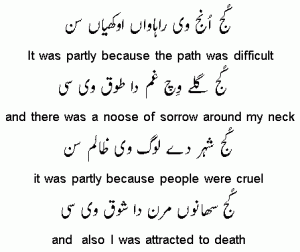
The mention of Pakistan's literary heritage would be utterly incomplete if mention of Dr Sheikh Muhammad Iqbal is not made. V G Kierman in his introduction to "Poems of Iqbal" writes, " Like all great poets of affirmation, Dante, Milton and Goethe, Iqbal was no abstract thinker. Like them he was closely involved with affairs of the world around him, and for the Muslims of the sub-continent, he has been not the unacknowledged, but the acknowledged law giver of their social, religio and political thinking." Read More about this poet philosopher.
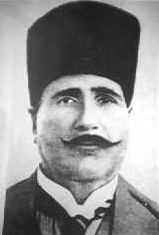

Iqbal came in a time when the Muslims all over the world in general and in the British India in particular were on the decline and mostly subjugated. The once mighty Ottoman Empire had crumbled and no ray of hope was in sight for their rising again on their own. There was also a need for the liberation of the Muslim minds from the sterility of social torpor and the tyranny of backward-looking anti-intellectual orthodoxy. With this theme in the backdrop, Iqbal chose to be a poet to revive the lost ego of the Muslims or the self - Khudi to meet the challenges of creation, the human self has to be fortified both by perceptual knowledge of the physical world and intuitive passion for the realization of higher values and ideals. His poetic works like the "Asrar-e-Khudi (insight to selflessness), Payam-e-Mashriq (Message from the East) and a number of collections like the "Baal-e-Jibreel, Zaboor-e-Ajam, Bang-e-Dara, Zarb-e-Kaleem".
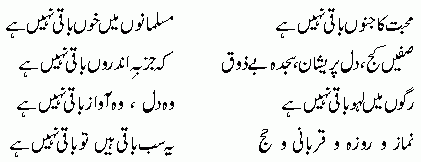
All his poetical works were philosophical, but aimed at rejuvenating the lost spirits of the Muslims to make them stand up before the demagogues for their rightful rights. His work to the cause of the Muslims got him accepted as the leading thinker in Muslim community and was thus later elected member of Punjab Legislative Assembly in 1926. He also became the President of All India Muslim League and it was he who invited Muhammad Ali Jinnah to join the League and lead the Muslims in their struggle for a separate independent homeland, Pakistan.
Having sown the seeds of Pakistan and shown the ray of hope, Iqbal didn't live longer and left for the eternal abode on 21 April, 1938 - 9 years before his dream could come true. For his love for Lahore, a city from he graduated and taught for many years, he was buried at the foot of the grand Badshahi Mosque. Read More in the exclusive section about Iqbal.
Customs and Traditions of Pakistan
| | Marriages: | |||
| | Food and Eating Habits: | |||
| | Rest and Recreation: | |||
| | Attire The dress in Pakistan varies from region to region, keeping in view the climatic conditions of the area. However, it is colourful and eye dazzling, specially on weddings, when the women folk wear brightly coloured attire with matching ornaments / jewellery. Men usually wear "Shalwar Kameez", though on marriages, embroidery is also added even for men. In rural ares, as a sign of respect, turbans or caps are worn by men, specially by the village elders. Women in rural areas and most of the women in urban areas as well, cover their head and most of the upper body as a religious obligation and also as a mark of modesty. The dress of Kalash people in remote areas of Chitral is unique with black robes and colourful embroidery. Read More ... | |||
| | Music and Dance Dances are very popular all over the country in varying forms. Owing to the Islamic culture, mostly men take part in dances publicly, however female dancers too exhibit their skills in group dances and in theatre and cinema. Above a group of dancers is seen performing "Hey Jamalo" from Sind, based on the fabled Jamalo, who returning victorious was greeted by his tribe "Hey Jamalo". "Luddi and Bhangra" are famous dances in Punjab, at the beat of big drums and are normally related to harvest season (top right), while "Khatak Dance" (top left) basically a sword dance is much popular in NWFP. Musical instruments like Dhol(drum), Shehnai (clairnet), sitar (three stringed instrument), sarod, alghoza (two wind piped flute) and flute are some of the widely used instruments. While the music in the rural areas continue to follow the regional and indigenous tastes and traditions, music in the urban areas is changing over from the film music, which once used to be the most popular genre, to pop music. Many groups and solo artists have thrived the music scene and people have a wide choice to make from. However, traditional classical and religious music is still available as are film songs |
Festivals
Festivals and fairs inject life and vigour in the lives of the people living anywhere in the world. Be it tomato throwing or racing in front of fuming bull, despite the danger the show goes on with lots of fun and laughter. Likewise, people in Pakistan have their own way of sharing love and joy.

Islamic Religious Festivals
Eid ul Fitr and Eid ul Azha are the two major religious festivities celebrated throughout the country among its Muslim populace.
-
Thankfulness is one of the four qualities of a Muslim, others being truthfulness, modesty and good behaviour. Eid ul Fitr is the day of rejoicing and thanksgiving to Allah for giving the strength to the believers to fast for 29-30 days during the holy month of Ramadan. The day is celebrated at the end of the Ramadan on the first of Shawal (the 10th month of Islamic calendar). In the evening of 29th Ramadan, all men and women alike flock on the rooftops to witness the new moon. No sooner it is sited, a euphoria sets in and everyone rushes to market places to make the last day shopping. Girls flock the stalls to get their hands beautiful decorated with "henna". On Eid day, women folk prepare delicious sweet dishes to celebrate the beginning of the day. Before going for the exclusive morning prayers, each head of the family is to give "fitrana" (alms) equal to 2 1/2 kilo of wheat in respect of each member of his family to the poor and needy so that they could also share the joy and happiness of the day. After the prayers children gather around the head of the family to receive "Eidi" - a sum of money as per the status and financial position of the head - a ritual in which everyone shares. A lot of fairs are organized for children while the elders call on to the relatives. More than men, women and children (specially girls) enjoy the festivities of the day by wearing colourful specially made-for-the-occasion clothes.

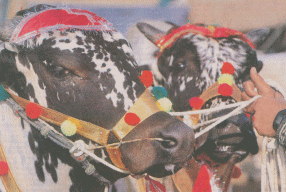

-
Eid ul Azha is celebrated on 10th day of the Zil Hajj (the 12th Islamic month). This day is celebrated in the memory of the sacrifice made by the prophet Abraham (Abraham) wherein he offered the life of his son Prophet Ismail to fulfill the decree of the Allah. On this day, all people who can afford sacrifice a sheep or a goat in the name of Allah as was done by prophet Abraham. Here too the poor are not forgotten. The meat of the sacrificed goat/sheep/lamb is divided into three parts; one for distribution among the poor, second for the relatives and third for self and own family.
-
In addition to the two Eids, the 12th of Rabi-al-Awwal (3rd month of Islamic calendar) is celebrated as the birthday of the prophet Muhammad (may peace be upon Him) with religious zeal and fervour. The roads, shops and other buildings are skillfully decorated with buntings and lights to express love and devotion to the Prophet Muhammad (may peace be upon Him). Special conferences are held to project the peacefulness of the religion of Islam and the way the prophet Muhammad (peace be upon him) desired it to be followed. How sad it is that a faction of Muslim hardliners have given a new and ugly dimension to this peaceful religion by terrorizing the world. This certainly isn't the Islam Allah and His Prophet wanted. Islam continues to be a religion of peaceful co-existence despite what some radicals are trying to portray it otherwise.
Non Muslim Religious Festivals
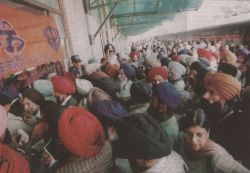
The Christian community celebrates Christmas, Easter and other religious festivals as are celebrated all over the world. Although the Christmas day coincides with the birthday celebrations of the father of the nation, Muhammad Ali Jinnah, on 25th December, Muslims also visit homes of Christian friends to celebrate Christmas with them. The other minorities like Hindus, Sikhs and Parsis also celebrate their religious days with equal enthusiasm. In fact the largest community that comes from all over the world to Pakistan are the Sikhs who flock their religious sites in thousands, specially the Baba Guru Nanak birthday celebrations, in November each year.
Spring Festivals
Spring always brings happiness and adds hues to life as flowers blossom and birds sing and chirp happily. Lahore, the city of gardens covers itself with multicolour flowers and it is then that the festivities of Spring Festival, locally known as the "Jashan-e-Baharan" get into their full swing. Likewise all over the country, the spring is welcomed with dance of men and trained animals and music. Some of the festivals worth mentioning are:
Basant in Lahore (Courtesy Abbrar)
|
Pakistani Cuisines and Selected Recipes
| MUTTON DISHES | | MUTTON CURRY | MUTTON MASALA | KASHMIRI RAAN | KARAHI GHOSHT | GHOSHT DO PIAZA | HANDI GOSHT | |
| CHICKEN DISHES | | MURGH CHANAY | MULTANI CHICKEN CURRY | LAHORI CHICKEN | MURGH TAWALA | CHICKEN TIKKA | BADAMI WHITE CHICKEN | GREEN CHICKEN | | CHICKEN BALLS | |
| VEGETABLE DISHES |
| RICE DISHES | | PESHAWARI BIRYANI | SHAHI MATAR PULLAO | KACHI CHICKEN BIRYANI | |
| KABAB / TIKKA | | BIHARI KABAB | BEEF TIKKA | CHAAMP KABAB | HUNTER BEEF | TANDOORI SEEKH KABAB | MURG TAWA KABAB | |
| DAL DISHES |
| PAKISTANI BREADS |
| MUTTON CURRY | MUTTON MASALA | KASHMIRI RAAN |
| Ingredients | Ingredients | Ingredients |
| 500 gm mutton pieces with bones | 2 tsp coriander seeds 1 & 1/2 tsp red chilly powder 1 tsp cumin seeds 1 tsp all spice 1 & 1/2 tsp ginger / garlic paste 2 inch raw papaya with peel ground1 onion minced 500 gm mutton pieces with bones 2 tbsp yoghurt 1/4 cup oil 1 tsp salt | 1 tbsp poppy seeds 4 cloves 2 tbsps desiccated coconut 3 pieces of mace 2 onions chopped 1/2 nutmeg 2 tsp ginger / garlic paste 2 tsp red chilly powder 15 almonds blanched and chopped 2 tsp salt2 sticks cinnamon 1 tbsp aniseed 6 green cardamoms 1 kg. 500 gm leg of lamb 3 black cardamoms 1/2 cup oil 1 cup yoghurt 4 - 5 cups of water |
| Cooking Instructions | Cooking Instructions | Cooking Instructions |
| Boil the mutton in the water till it is tender. Strain and set aside. Grind the coriander, cumin, red chilly powder, curry powder and ginger/garlic. Heat the oil and fry the onions toll they are light golden in colour. Add the curry leaves and ground spices. Stir and fry for a few minutes till the oil separates. Add the mutton. When it boils, add meat, potatoes and coconut milk. Cook gently till the potatoes are done. Add the salt and tomato paste or tamarind water. Stir through and serve | Roast and grind the coriander and white cumin seeds. Mix all the ingredients except the mutton and oil. Put the mutton pieces in this marinade, coat it well and set aside for 2 hours. Heat the oil. Fry the mutton pieces with all the marinade. Cover and let it cook. Then add 1 & 1/2 cups of water. Cook till the meat is tender. | Place all the ingredients, from the poppy seeds to the aniseed, in a blender and blend to a smooth paste. Then prick the leg of lamb, with a fork, on all sides. Cover the lamb well with the paste. Heat the oil, put the leg inside and fry it on all sides. Now add the water and continue cooking till the leg of lamb is tender and the oil floats on top. It takes about 1 & 1/2 hour for the leg to get tender. |
| KARAHI GHOSHT | GHOSHT DO PIAZA | HANDI GOSHT |
| Ingredients | Ingredients | Ingredients |
| 1/2 cup oil or ghee | 500 gm mutton pieces with bones | Mutton 1 kg |
| Cooking Instructions | Cooking Instructions | Cooking Instructions |
| In a karhai or wok put the oil, mutton, tomatoes, salt, red chilly powder, ginger / garlic and onions. Cook over a medium heat till the meat is quite tender. Add to this the coriander powder, turmeric powder, black pepper, black cumin seeds and all spice. Stir and cook for some time till the oil separates. Add the yoghurt, green chilies and let it cook cook for a few minutes. Turn into a serving dish and sprinkle the coriander leaves on top. | In a pan put the mutton, onions, cloves, black peppercorns, cinnamon, ginger, garlic/ red chilies and water. Cook over a low heat. When the water dries add the oil, tomatoes and green chilies. Stir and cook for a few minutes till the oil separates. When the meat is tender, sprinkle the coriander leaves, black pepper and all spice on top. Simmer over a low heat for 15 - 20 minutes till the oil floats on top. | Heat oil in a handi and fry chopped onion. When onions turn golden add whole spices and rest of masala. Add in mutton and bhuno well. Add in curd and fry. Then add 2 cups water, cover and cook till meat tender. After that add flour mixture and cook for 15-20 minutes on slow heat. Lastly add all spice and put on dum till oil floats on top. |
| MURGH CHANAY | MULTANI CHICKEN CURRY | LAHORI CHICKEN |
| Ingredients | Ingredients | Ingredients |
| Chicken 1 cut into 16 small pieces | 1/2 cup oil or ghee | Chicken 1 of 1 & 1/2 kg whole |
| Cooking Instructions | Cooking Instructions | Cooking Instructions |
| Heat oil and fry onions to a light golden the remove and crush and mix with curd. Add masalas to oil and fry by sprinkling little water than add curd with onion. Then add chicken and cover cook till chicken tender. Add your boild chanay and cook for 5 minutes lastly add chopped coriander, green chilies, ginger sliced and all spice powder. | Heat the oil. Add the onions and fry till they are golden. Then add the ginger / garlic and 1/4 cup water and stir fry till the oil separates. Put in all the seasonings and tomatoes. Stir and cook till the oil separates. Add the chicken and 1 cup of water. Cover the pot and cook for approximately 25 - 30 minutes, till the chicken is tender and dry. Stir in the tomato ketchup and lemon juice. Put the chicken in a serving dish. In a small saucepan, melt 2 tsp of oil, stir in 1/4 tsp red chilly powder and pour over the chicken. Garnish with chopped leaves. | Heat the oil in a pan. Fry the onion till it is light golden remove with a slotted spoon and crush. In the oil add the chicken pieces along with the khoya, red chilly powder, coriander powder, cumin powder, salt and approximately 1 cup of water and stir. After 5 minutes add the yoghurt mixed with the fried onion and lower the heat. When the chicken is tender and very little liquid remains add the cardamom powder, kewra, lemon juice, nuts, saffron and half a cup of water. Cook over a low heat for approximately 5-10 minutes till the oil floats on top. |
| MURGH TAWALA | CHICKEN TIKKA | |
| Ingredients | Ingredients | Ingredients |
| 1 Chicken cut into 16 pieces | MAKHANI GRAVY: | Chicken 1 of 1 & 1/2 kg cut into 4 pieces and gie cuts washed |
| Cooking Instructions | Cooking Instructions | |
| Prick the chicken pieces with a fork. Mix the Ginger / Garlic, salt and 4 tbsps of oil. Cover the chicken pieces with this marinade and set aside for 30 minutes. Heat the remaining oil. Then add the chicken and stir. Add the onion, green chilies, red chillily powder, black pepper and ginger. Stir and cook till the oil separates. Add the "Makhani gravy" and cook over a low heat, for approximately 25 - 30 minutes, till the chicken is tender. Sprinkle the coriander leaves and all spice on top. In a saucepan combine the first 6 items listed under MAKHANI GRAVY and cook till they blend. Bring to a boil, then add the butter and cream, stir through, add the fenugreek. | Mix all in lemon juice and marinate the chicken well with all this for 2-3 hours. Put on skewers and BBQ them. After they are half cooked, brush it with little ghee and cook till done on both side about 15 minutes. Serve with chutney or bake in a pre heated oven on 180'C for 1/2 an hour and give dam of coal. | |
| BADAMI WHITE CHICKEN | GREEN CHICKEN | CHICKEN BALLS |
| Ingredients | Ingredients | Ingredients |
| Chicken 1 cut into 10 pieces | Chicken 1 kilo | 1 Chicken of 1 & 1/4 kg |
| Cooking Instructions | Cooking Instructions | Cooking Instructions |
| Put about 1 cup water in a pan and add your chicken with grinded hara masala and salt and cook on low flame. Then add in curd and almond mixture stir well and cook covered on low flame. Heat 1/2 cup oil on a fry pan add in 1 tsp crushed garlic and fry till golden. Add to the chicken and cook till gravy thickish like korma. Serve garnished with boiled egg serve with naan or Taftan. | First grind coriander and chilies in a mixer. then take a deep pan and put chicken, chill and coriander paste and ginger, garlic paste and cook it for 15 min | Boil the chicken, with all the seasonings and some water. Till the chicken becomes tender and thick gravy remains. Now shread the chicken and remove bones. Mix the soaked slice of bread in chicken and add 1 beaten egg. Mix well and form balls. Dip the balls into beaten egg and roll in crumbs. Fry in deep oil till golden |
| MASALE WALE ALOO | CHEESE (PANEER) PALAK | BRINJAL SABZI |
| Ingredients | Ingredients | Ingredients |
| Small round potatoes 1 kg | Cottage Cheese 8 Oz | Brinjal 1 pao sliced and fried |
| Cooking Instructions | Cooking Instructions | Cooking Instructions |
| Boil potatoes with salt. Heat oil, add curry patta, fry the masala. Fry very well by sprinkling little water till oil floats on top. Add in potatoes mix well simmer on low fire for 5 minutes. Sprinkle in the chat masala and garnish with dhania and mint leaves. Mix all in imly juice. | Cut Cheese in cubes and fry slightly in butter or oil. Heat butter or oil fry onion golden add the ginger / garlic, chilly powder and salt, fry a little, add curd and fry, add the flour and fry a little. Add the spinach blended. Cook for a while add cream add the fried cottage cheese. Sprinkle all spice and put on dam. | Heat oil add Kalonji and saunf when brown add rest of masala and fry. Add chopped tomato cover and cook till soft than add in the fried brinjals and put on dam lastly add in chopped green chilies and coriander leaves chopped. |
| PESHAWARI BIRYANI | SHAHI MATAR PULLAO | KACHI CHICKEN BIRYANI |
| Ingredients | Ingredients | Ingredients |
| Chicken 1 cut into 16 pieces | 500 gm Rice washed and soaked for 30 minutes | 1 kg & 500 gms Chicken cut into 12 pieces |
| Cooking Instructions | Cooking Instructions | Cooking Instructions |
| Boil chola. Cut the chicken in pieces. Heat oil fry all the masala except tomato, spring onion, coriander, mint and green chilies. Add chicken and cook with 1 cup of water when tender and water dries remove. Boil rice with salt till 3/4 done. Put chicken, boiled choley, chopped tomato, spring onions and chopped hara masala in between layers sprinkle zeera on top. Put on dam for 15 min. | Heat the oil. Add the black peppercorns, cloves, cinnamon, green and black cardamoms, crushed brown onions and ginger / garlic. Add approximately 2 table spoons of water, stir and fry till the oil separates. Add the salt, red chilly powder, yoghurt and peas. Stir for a few minutes add the drained rice and enough water for the rice to cook in. When the rice is ready, let it simmer over a low heat for 10 minutes. Garnish the pullao with the nuts and eggs. | Marinate the chicken in a mixture of the yoghurt, ginger / garlic, red chilly powder, salt and 1/2 of each of the following: crushed onions, oil, mixed spices, coriander and green chilies. Set aside for 2 - 3 hours. Boil the rice with the cinnamon, white cardamoms, black cumin seeds and salt till it is half-cooked. In a pan spread the chicken including all the marinade, followed by the rice. Over this put the remaining crushed onions, oil, mixed spices, coriander and green chilies. Sprinkle the saffron and kewra on top. Knead the flour with the water to make a dough. Cover the pot and seal the edges with the dough. Cook over a high heat for 5 - 7 minutes, then lower the heat and continue cooking for another 25 - 30 minutes. |
Minced Meat / Beef / Chiken Kabab / Tikka
| BIHARI KABAB | BEEF TIKKA | CHAAMP KABAB |
| Ingredients | Ingredients | Ingredients |
| 1/2 kilo beef pasanday (filets) | 1/2 kilo cubes of beef | 500 gm lamb chops |
| Cooking Instructions | Cooking Instructions | Cooking Instructions |
| Mix together all the spices and yogurt and papaya and coat the beef with it. Leave to marinate for 5-6 hours preferably overnight. Then barbeque over charcoal or you can bake it | Mix together all the spices and yogurt and papaya and coat the beef cubes with it. Leave to marinate for 5-6 hours preferably overnight. Then barbeque over charcoal. | Wash the chops and pierce them all over with a fork, par-boil and drain them. Rub the ginger / garlic, salt and pepper on the chops. Then spread the onions on top and set aside for 15 minutes. Beat the eggs until they are fluffy and then pour over the chops. Sprinkle the vinegar on top. Heat the oil and fry until they are golden-brown. |
| HUNTER BEEF | TANDOORI SEEKH KABAB | MURG TAWA KABAB |
| Ingredients | Ingredients | Ingredients |
| Beef 1 & 1/2 kg 1 piece | Keema 1/2 | 1 Chicken bon less cut in 1" pieces |
| Cooking Instructions | Cooking Instructions | Cooking Instructions |
| Grind the spices fine and marinate with all the ingredients and prick very well on both sides. Keep for 5 days in fridge and keep pricking daily. Then wrap the piece and tie it with a string. Put about 3 cups water in a pan and put the roast piece along with its own water and masala and leave it to get tender and when the water dries and meat tender. Remove and let it cool and afterwards cut into slices. | Slightly roast saunf, dhania and poppy seeds and grind with chana finely. Squeeze out all water from washed mince and put it in a bowl with grinded onion, ginger / garlic, papaya, grinded green chili, mint and coriander leaves also add in dry masala, and egg and mix all very well and leave for 1 hour. Then shape into seekh kababs. Heat little oil on tawa and shallow fry it afterwards bake it for 10 minutes and give dam of coal. | Marinate chicken with all above masala for an hour. Heat oil on tawa and spread chicken botis on the tawa, sprinkle a little water on it then cover and cook when water dries and oil comes on top. Remove give dam of coal. |
| DAL PALAK | DAL MASH AND KEEMA | SPICY DAL CHANNA |
| Ingredients | Ingredients | Ingredients |
| Moong ki dal 1 cup | Dal mash 1 cup | 2 cups dal channa (gram lentils) 6 cups water, 2 teaspoons garlic paste, 2 teaspoons ginger paste, 1-1/2 teaspoons chili powder, 1 teaspoon coriander powder, 1 teaspoon turmeric powder (haldi), 1 cup oil, 1 medium onion sliced, 1/2 teaspoon cumin seeds, zeera, 2 - whole dried red chilies, crushed, 1 teaspoon garam masala powder, 3 tablespoons coriander leaves, chopped 3 - green chilies, 2 teaspoons |
| Cooking Instructions | Cooking Instructions | Cooking Instructions |
| Cook dal till half done with haldi. Add in finely chopped palak, soya sauce, methi and ciik till done and add salt. Heat oil and fry ginger, onions, green chillies till slightly brown and pour on top of the dal before serving add in finely chopped coriander leaves and green chilies. | Heat oil and brown onions. Add ginger /garlic and fry after that add mince and fry. When brown add haldi, chilly powder, salt, little water and fry. When it leaves oil, add dal and fry. Add enough water for dal to be soft. Add green chilies, coriander leaves and all spice and put on dum. | Wash dal channa thoroughly and kepp it soaked in water for 3-4 hours. Put the drained lentil in a heavy medium skillet; add water, garlic and ginger paste, chili powder, turmeric, coriander powder and salt. Place the skillet over high heat and bring the lentil to a boil then reduce heat to low, cover and simmer until lentil is tender and slightly mushy, about 25-30 minutes. (Add more water, if all the water has evaporated and the lentil is still hard.) Transfer lentil to a serving dish and cover with the lid to keep the lentil hot. |
| Ingredients | Ingredients | Ingredients |
| 6 cups maida (white flour) | Flour 225 gms | 2 c. whole wheat flour |
| Cooking Instructions | Cooking Instructions | Cooking Instructions |
| Mix all the ingredients and knead into a dough. Cover with a damp cloth and leave at room temperature for 2-3 hours. Then divide it evenly into 12 parts. Roll out into flat chapati which are as thick as a pizza crust. Bake in oven at 350* till light brown. Can also be frozen after baking for later use. | Sift flour and add soda, rub ghee and knead with luke warm milk. Leave for 2 hours. Make in the shape of Nan. Prick it and brush with milk. Sprinkle sesame seed and bake at mark 6 or 200° | Mix flour, salt, and yeast in a bowl. Combine the oil and water and slowly mix it into the dry ingredients. Let rise for 1-2 hours. Makes one dozen balls out of the dough using more flour as needed to keep them from sticking. Cover them with a wet towel until ready to use to prevent them from drying out. Preheat the oven to 500 degrees. Roll each ball into a flat round Chapati as thin as possible, sprinkling with flour as you go the help prevent sticking. Bank one side of each Chapati becomes light brown, remove it with the tongs and keep it in a towel. These can be eaten plain or with butter and served with soup, meat, and vegetables. |
| GAJRELLA | GAJAR KA HALWA | ZARDA |
| Ingredients | Ingredients | Ingredients |
| 250 gm carrots, grated | 1/4 cup oil | 1 kilo rice presoaked |
| Cooking Instructions | Cooking Instructions | Cooking Instructions |
| Steam the carrots slightly. Boil the milk, then add the carrots and rice. Cook till the carrots and rice are tender. Add the sugar and continue cooking till it is of a thickish consistency. Add the saffron and cardamom powder. Remove from heat and pour into a glass serving bowl. Sprinkle the nuts and place the warq on top. | Wash the carrots and grate fine. Blanch and chop almonds and pistachio and crush ilachi. Mix zafran in 1 tbsp water. Boil the milk and add carrots, stir carefully and cook slowly till milk is almost absorbed. Add sugar, dry fruit and cook till mixture is nearly dry. Then add the melted ghee gradually and fry till rich brown. Now add ilachi and zafran and cook till ghee separates. | Soak the rice for at least an hour.In pot add water till half full. Add color, 5-6 cloves and 4-5 illaichi, boil and add rice. When the rice is almost cooked then drain. |
| CHANAY KI DAL KA HALWA | ANDOON KA HALWA | GULAB JAMAN |
| Ingredients | Ingredients | Ingredients |
| 1 cup dal chana | 5 eggs | DOUGH: |
| Cooking Instructions | Cooking Instructions | Cooking Instructions |
| Cook the dal with water and when the dal is tender add milk and cook again till the milk dries. Remove and grind the dal well. When it is fine, mix the dal paste, sugar, ghee and 1 egg and cook it on slow fire and gradually increase the heat. When you can smell a unique scent, bhuno it on fast fire till a colour comes. Take it off the fire and put zafran, kewra, almond and pistachios. | Mix all the ingredients and cook on slow fire. Keep on stirring till the mixture gets thick. Pour mixture in tray. Put almonds and pistachio and cut in diamond shape. | Combine all the dough and ingredients & make their dough. Now make their small balls (almost 18-20 balls) |
| KHEER | Sewian (Vermicelli) | Rice Flour Pudding |
| Ingredients | Ingredients | Ingredients |
| 1 stick Butter 2 handfuls Very fine vermicelli 4 cups Milk 1 pint Whipping cream 1 handful Raisins 3 tblsp Sugar 4 Almonds (optional) peeled and thinly sliced | 2 c Sewian (vermicelli) 3 1/2 c Milk 3/4 c Sugar 1/4 t Rose water (or 6-8 small cardamom seeds) Ghee | 4 1/2 c Milk 3/4 c Sugar 2 oz Rice flour 6-8 drops Rose water 1 oz Almonds 1/2 oz Pistachio nuts |
| Cooking Instructions | Cooking Instructions | Cooking Instructions |
| Melt butter in a 4 qt pot. Break vermicelli into 3" pieces. Over low heat stir vermicelli into butter until it turns light brown. Pour in the milk and stir over medium heat until it boils. Put in the raisins, almonds and sugar. Continue to cook under low heat for 10 minutes. Add whipping cream and continue to cook for a couple of minutes. Remove from heat and, when cool, chill in the refrigerator before serving. | Fry the sewian in hot oil until golden brown. Heat the milk to boiling and add the sewian. Cook until the milk is reduced by half. Add sugar and cook on low heat until creamy (about 25 minutes). Remove from the heat. Add in rose water. Decorate with blanched finely shredded almonds and pistachio nuts and silver leaves if desired. | Blanch (optional) and shred nuts. Mix rice flour into the milk and mix until smooth. Cook over medium heat until a creamy consistency is achieved (20-30 minutes?). Simmer and add sugar and stir for 2-3 minutes more. Cool (in refrigerator for 30 minute) add the rose water, almonds and pistachios (maybe before it cools). Pour into individual dishes and serve. |
Traditional Breakfast of Halwa and Poori, served with Aloo ki Bhujia and Cholay
| POORI | CHOLAY | ALLO KI BHUJIA |
| Ingredients | Ingredients | Ingredients |
| 2 c. whole wheat flour 1/2 tsp. dry yeast 1/2 tsp. salt 1 tbsp. oil 1 c. water | 1/2 cup boiled Chanay 1/4 tsp. salt 1/4 tsp baking soda 1/4 tsp cumin seeds powder 1/4 tsp crushed whole red chilies 1/8 tsp. turmeric powder 1/8 tsp garam masala powder | 250 grm potato 1/2 tsp. salt 1/2 tsp red chili powder 1/4tsp. turmeric powder 1/2 tsp. onion seeds |
| Cooking Instructions | Cooking Instructions | Cooking Instructions |
| Sift flour, salt rub ghee, knead with water to a soft dough. Make balls, roll into small size pooris. Deep fry in hot oil. | In a pot put softened Chana, 1½ cup water and add spices. Cook till very tender. Mix and mash slightly. Cook till bubbles appear then remove from heat. | Cut the potatoes into small cubes. Add spices, 1 cup of water and leave on low heat. When soft, mash lightly. |
Lahore Food Streets
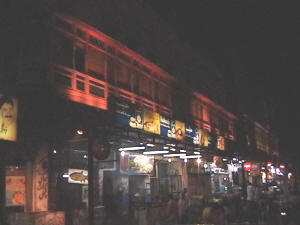
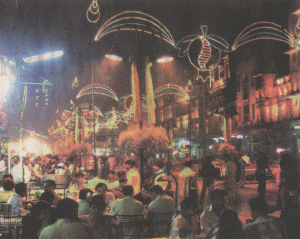
Lahore is city of live hearted people, always finding an occasion for enjoyment, entertainment and good feast. While parks and other recreational facilities are filled with holiday makers, specially on weekends, the eateries are seldom found vacant throughout the weekdays. The traditional food of Lahore is found in the Walled City of Lahore, while the western and Chinese cuisines are generally found in the posh localities of Lahore Cantonment, Gulberg, Shadman and Shahjamal.
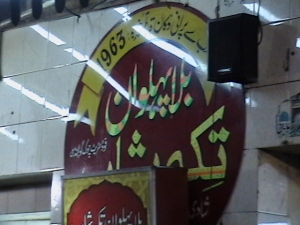
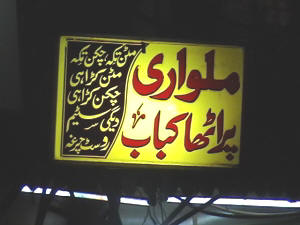
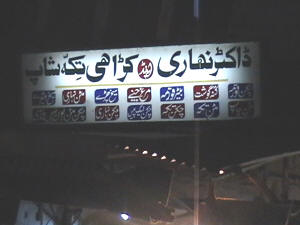
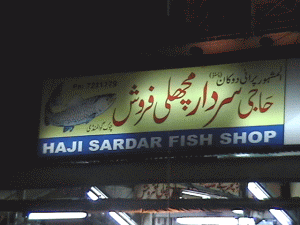
However, recently, a novel idea of establishing Food Streets outside the Walled City for the easy access to locals and tourists has gained much popularity. The first food street was opened in an alley of Gawalmandi, near the famous Mayo Hospital on Nisbat Road. The idea was to bring out the old and traditional foods for all and sundry at one place. Now the famous "Phajjay kay Paye" (joints of goat) originated from old Lahore, are available here, besides the Doctor Nihari, Sardar's fried fish, pathooray, katlamma and much more. Besides for the sweet tooth, a variety of sweet dishes are available like jalaibees, firni, kheer and others.
But that is not all. The old houses overlooking the streets have been renovated and their old balconies redone with wood carving and lights installed to provide more hues to the street down below. These look more enchanting and mystic through the sizzling smoke of BBQ food being prepared in abundance round the clock.
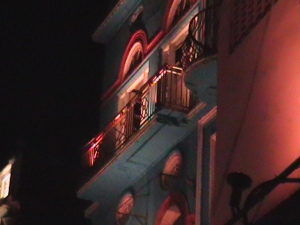
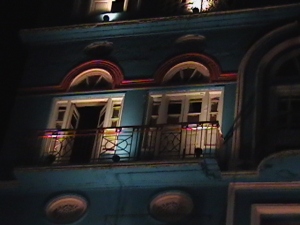
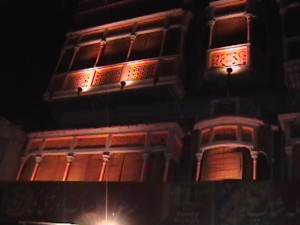
Lahorites bring their outstation guests to these streets to show their typical hospitality. And order kilos of various varieties of cooked meat, chicken, fish and other food items. After the food, a glass of iced Lassi, made of yogurt, water, sugar and "pairay" - a sweet made of thickened milk and sugar, served in large aluminum glasses adds to the everlasting taste (below right). Those who are good at it, prefer to drink it in one breath, called "deek" in local Punjabi language. Try it next time.
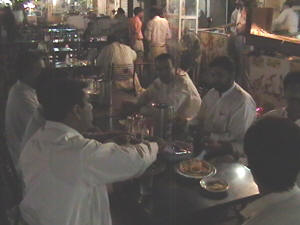
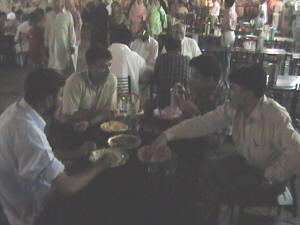
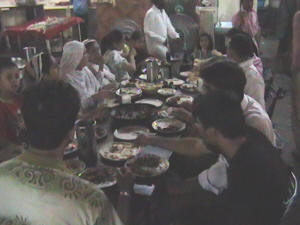
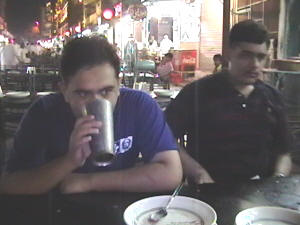
By the way, do not forget to eat "paan" - many substances wrapped in the beetle leaf, before leaving the Food Streets. These "Paan" sellers have deliberately established their shops on the entrance of the streets to provide the last taste of a wonderful evening spent in the food streets. The Food Streets close in morning around 8 am after serving the traditional breakfast of "Hawla and Poori" served with Lassi, Nihari and Hareesa. These dishes are difficult to describe and digest too since these are very rich in oil and peppers. so be careful, just in case.
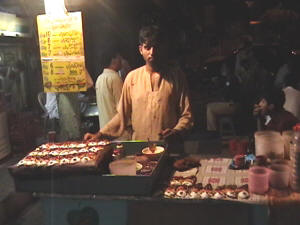
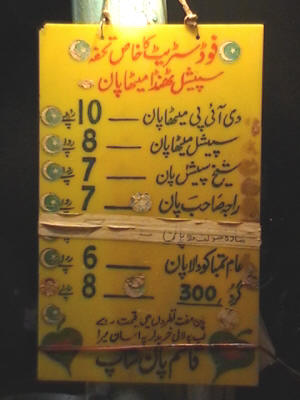
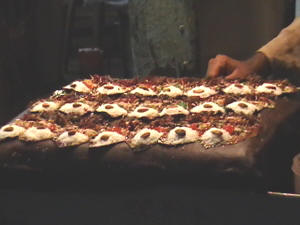
"Paan" seller at the entrance of Gawalmandi Food Street
Other two Food Streets are located in Old Anarkali (off the Mall Road) and in the Walled City of Lahore. These remain open throughout the night and are seldom found empty. Now Lahorites treat their guests, specially from outside Lahore in the Food Streets rather than anywhere else.
--
میرا نیا بلاگ - اپنی رائے کا اظہار کیجئے
http://shoaibtanoli.wordpress.com/
Regards
M Shoaib TaNoLi
Karachi Pakistan
Email@ shoaib.tanoli@gmail.com
Cell # +92-300-2591223
Facebook :https://www.facebook.com/mtanoli
SKYPE: shoaib.tanoli2
پاکستان زندہ باد ۔ پاکستان پائندہ باد
Long Live Pakistan
Pakistan Zindabad!
Dear Readers: My mails are my personal choice. The purpose of these mails is to establish contact with you, make you aware of different cultures ,disseminate knowledge and information. If these (mails) sound you unpleasant, please intimate .
IF YOU ARE NOT INTERESTED IN MY MAIL
PLEASE REPLY THIS E_,MAIL WITH THE SUBJECT.. UNSUBSCRIBE
E Mail: shoaib.tanoli@gmail.com
--
پاکستان کسی بھی پاکستانی کے لئے اللہ کی سب سے بڑی نعمتوں میں سے ایک ہے. آج ہم جو بھی ہے یہ سب اس وجہ پاکستان کی ہے ، دوسری صورت میں ، ہم کچھ بھی نہیں ہوتا. براہ مہربانی پاکستان کے لئے مخلص ہو.
* Group name:█▓▒░ M SHOAIB TANOLI░▒▓█
* Group home page: http://groups.google.com/group/MSHOAIBTANOLI
* Group email address MSHOAIBTANOLI@googlegroups.com
To unsubscribe from this group, send email to
MSHOAIBTANOLI+unsubscribe@googlegroups.com
*. * . * . * . * . * . * . * . * . * . *
*. * .*_/\_ *. * . * . * . * . * . * . * . * .*
.•´¸.•*´¨) ¸.•*¨) ¸.•´¸.•*´¨) ¸.•*¨)
(¸.•´ (¸.•` *
'...**,''',...LOVE PAKISTAN......
***********************************
Muhammad Shoaib Tanoli
Karachi Pakistan
Contact us: shoaib.tanoli@gmail.com
+923002591223
Group Moderator:
*Sweet Girl* Iram Saleem
iramslm@gmail.com
Face book:
https://www.facebook.com/TanoliGroups
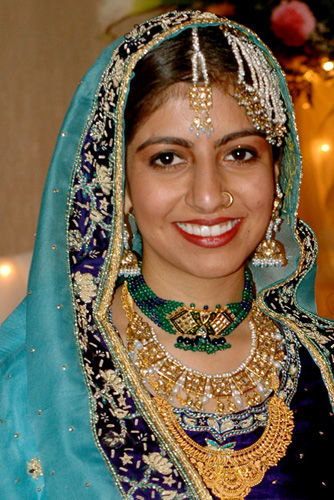
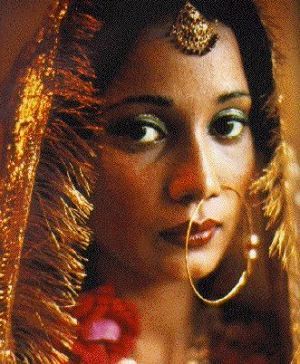
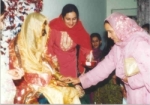
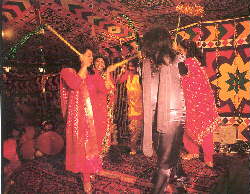
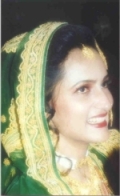
 The Pakistani cosines are rich in oil and chillies. Unlike the Indian food, Pakistani dishes must include meat, chicken and beef, though pork is totally forbidden as per Islamic teachings. Although eating habits differ from regions to region, the mainstay of the Pakistani diet is "chapati or roti" made from flour. "Lassi" a usual drink made like a milkshake in a home made utencil from curd/yogurt and water is usually taken at lunch time, specially during the summers as it beats the effects of hard weather. It is usually customary to eat a dessert after the dinner, which mainly comprises "Kheer" (made from rice and milk) and sweetened rice "Zarda". Rice though scarcely eaten in many parts, pulla´o (lightly fried rice with vegetables) and biryani (rice with meat or vegetables and spices) are the tw very favourite dishes of rice, specially on marriages. "Mithai" a kind of sweet made of corn flour, sugar and milk is the favourite sweet for all ages.
The Pakistani cosines are rich in oil and chillies. Unlike the Indian food, Pakistani dishes must include meat, chicken and beef, though pork is totally forbidden as per Islamic teachings. Although eating habits differ from regions to region, the mainstay of the Pakistani diet is "chapati or roti" made from flour. "Lassi" a usual drink made like a milkshake in a home made utencil from curd/yogurt and water is usually taken at lunch time, specially during the summers as it beats the effects of hard weather. It is usually customary to eat a dessert after the dinner, which mainly comprises "Kheer" (made from rice and milk) and sweetened rice "Zarda". Rice though scarcely eaten in many parts, pulla´o (lightly fried rice with vegetables) and biryani (rice with meat or vegetables and spices) are the tw very favourite dishes of rice, specially on marriages. "Mithai" a kind of sweet made of corn flour, sugar and milk is the favourite sweet for all ages. 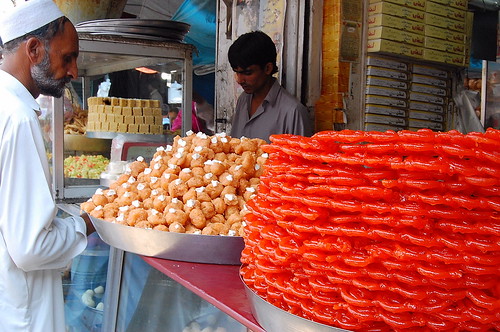
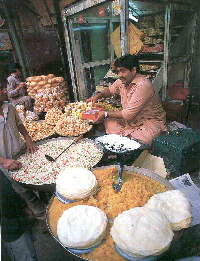 There are significant regional differences in cuisine. Curries of meat and chicken rich in spices are preferred in the south, while barbecuing and beef is more common in the north. The junk food is very popular in youngsters in cities, specially with the introduction of fast food like the McDonalds and Kentucky Fried Chicken. However, the indigenous snacks include samosas (deep-fried pastry triangles filled with potatoes, mixed vegetables or minced meat) and pakoras (floured and deep-fried vegetables). Tea with milk is the most popular drink both in urban and rural areas.
There are significant regional differences in cuisine. Curries of meat and chicken rich in spices are preferred in the south, while barbecuing and beef is more common in the north. The junk food is very popular in youngsters in cities, specially with the introduction of fast food like the McDonalds and Kentucky Fried Chicken. However, the indigenous snacks include samosas (deep-fried pastry triangles filled with potatoes, mixed vegetables or minced meat) and pakoras (floured and deep-fried vegetables). Tea with milk is the most popular drink both in urban and rural areas.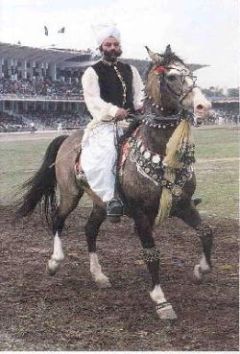 Sports are the real pastime and recreation for the majority of Pakistanis.
Sports are the real pastime and recreation for the majority of Pakistanis. 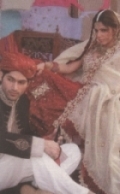
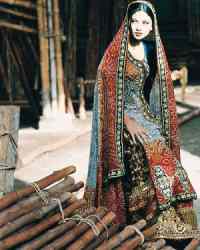
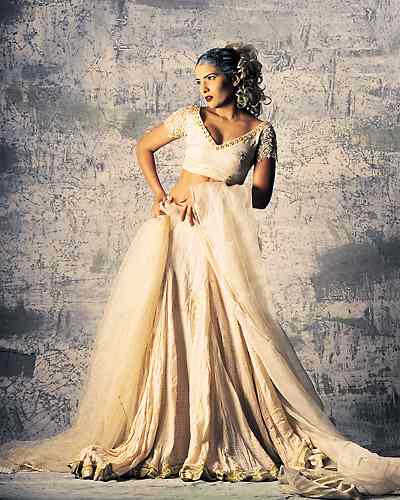

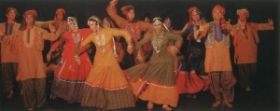
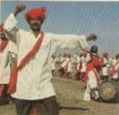

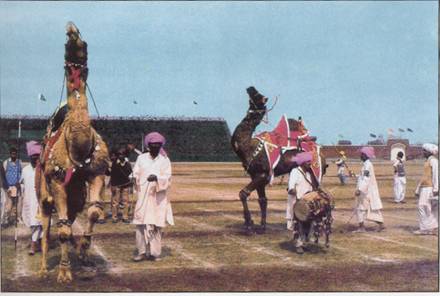
 The Basant or the Festival of Kite Flying is celebrated with much fanfare and pomp and show in mid February every year in Lahore.
The Basant or the Festival of Kite Flying is celebrated with much fanfare and pomp and show in mid February every year in Lahore. 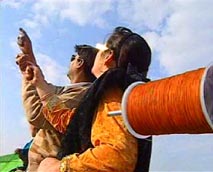 The kite flying is a favourite pastime of Lahorites who start preparing for the festivals much in advance. The main venue for kite flying is the old Lahore, where from dawn to next dawn (including night) flyers along with their families and friends flock on the roof tops and organize competitions.
The kite flying is a favourite pastime of Lahorites who start preparing for the festivals much in advance. The main venue for kite flying is the old Lahore, where from dawn to next dawn (including night) flyers along with their families and friends flock on the roof tops and organize competitions.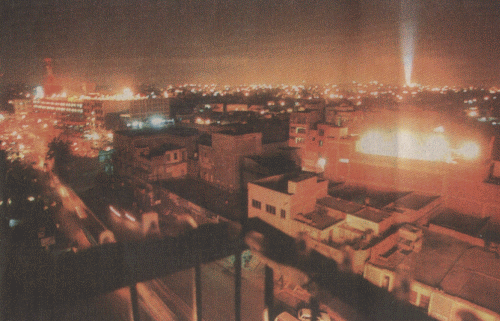 The kite flying even continues during night in the flood lights and the whole old Lahore is lit up in a scene to be witnessed and not described.
The kite flying even continues during night in the flood lights and the whole old Lahore is lit up in a scene to be witnessed and not described. 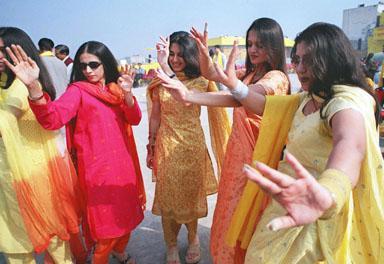 Yellow is indeed the main colour in this event as it depicts the blossoming spring flowers in the fields of Punjab.
Yellow is indeed the main colour in this event as it depicts the blossoming spring flowers in the fields of Punjab.  Basically a military fanfare, which by and by has included more of rural people who bring their well fed and high quality breed horses, cattle and other animals. Cattle races & dances, tent-pegging, folk music, dances, bands, cultural floats and folk games add colour to the festival. In the evening a special tattoo show is held by the Army which creates an atmosphere of is own with hundreds of torches lit in darkness and performed skilfully in many arrangements.
Basically a military fanfare, which by and by has included more of rural people who bring their well fed and high quality breed horses, cattle and other animals. Cattle races & dances, tent-pegging, folk music, dances, bands, cultural floats and folk games add colour to the festival. In the evening a special tattoo show is held by the Army which creates an atmosphere of is own with hundreds of torches lit in darkness and performed skilfully in many arrangements.  When the other provinces are enjoying their festivities, the Silk Route Festival on the Roof of the world attracts visitors from many a adjoining countries including Xingjian Province of China and Central Asia flock together in the highest mountains of the world amid some breathtaking spectacles of scenic beauty, wildlife and nature and awe-inspiring snow peaks. The festival included folklore, arts, crafts and display of cultural heritage.
When the other provinces are enjoying their festivities, the Silk Route Festival on the Roof of the world attracts visitors from many a adjoining countries including Xingjian Province of China and Central Asia flock together in the highest mountains of the world amid some breathtaking spectacles of scenic beauty, wildlife and nature and awe-inspiring snow peaks. The festival included folklore, arts, crafts and display of cultural heritage. 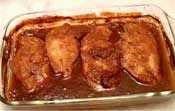

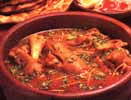
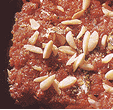
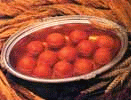
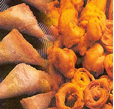
No comments:
Post a Comment